Heinrich Biber’s meditations on the mysteries of the Rosary are virtuoso violin sonatas that significantly extended the technical challenges for the violin. The five Glorious Mysteries contemplate The Resurrection of Christ, his Ascension into Heaven, Pentecost, The Assumption of Mary, and her Coronation as Queen of Heaven. These are followed by a concluding Passacaglia for unaccompanied violin, The Guardian Angel.
The performers - Anne Loeser (baroque violin), Jane Young (baroque cello), Bethany Angus (organ & harpsichord)

Baroque cellist Jane Young Photo: Supplied

Baroque violinist Anne Loeser Photo: NZSO
Find out more and listen to this performance here:
BIBER: Mystery Sonata No 11, The Resurrection
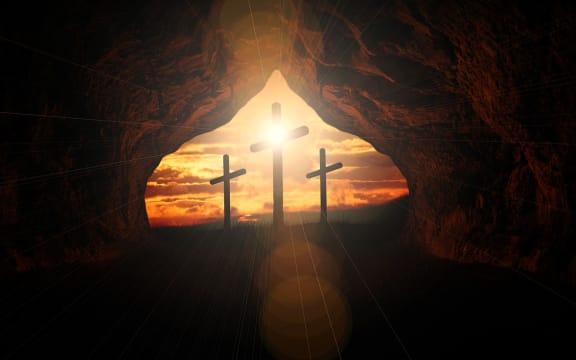
Image suggesting the Resurrection Photo: PhotosForClass
Performed by Anne Loeser (baroque violin), Bethany Angus (organ)
The most unusual feature of this sonata is its scordatura. For the Resurrection in G major, Biber requires the four strings of the violin to be tuned to two G’s an octave apart and two D’s an octave apart. And he requires that the two inner strings be reversed, crossed over, which destroys the normal upward progression of the open strings and demands a whole new mental and physical approach to putting the right finger, in the right place, on the right string. The notation system Biber uses for this is simple in its logic but devastating in practice. And the symbolism of the crossed strings shouts at us across the three hundred and fifty years since The Resurrection Sonata was written. The two inner strings are crossed over between the tailpiece and the bridge, then they must be crossed back again at the other end, in the peg box. This gives two crosses between the strings. And a third cross is implied by the right angle between the bow and the strings. Three crosses - the Holy Trinity - or Christ and two thieves crucified on Calvary.
There are many temptations to read programmatic elements into the Mystery Sonatas, but it is impossible to ignore the echoes in the empty tomb in the opening Sonata of The Resurrection. And as if in answer to the question posed by the empty tomb, Biber then gives us a long elaboration on the old Latin hymn “Surrexit Christus Hodie”, Christ Is Risen Today. This is followed by a rather chorale-like concluding Adagio.
Programme note by Gregory Hill.
Producer/engineer: David McCaw
BIBER: Mystery Sonata No 12, The Ascension
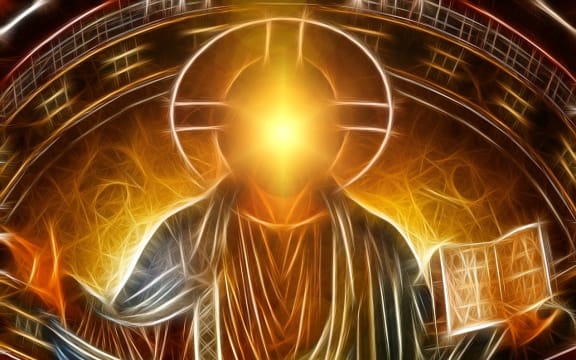
Image depicting the Ascension of Jesus Photo: PhotosForClass
Performed by Anne Loeser (baroque violin), Jane Young (baroque cello), Bethany Angus (harpsichord)
The second Glorious Mystery is The Ascension. St Luke’s Gospel, and the Acts of the Apostles, tell us that forty days after his resurrection, Jesus took his eleven apostles to Bethany near the Mount of Olives and blessed them there. Then before the dumbfounded gaze of the apostles, Jesus ascended into the sky and disappeared into a cloud. Two angels appeared and told the apostles that the same Jesus whose ascension into heaven they had just witnessed, would one day return by the same route. So, the crucial importance of the Ascension in Christian belief is that it establishes the possibility of Jesus' return to earth in the future.
Biber's take on it is a Sonata in C major with a scordatura, or mistuning, of C-E-G-C, a simple root-position C major chord, and the inner strings are no longer crossed over. It is the only one of the Mystery Sonatas to be tuned to a root-position chord. And the bottom string is painfully tight from the violin’s point of view, wrenched up a fourth to C. Biber starts with a short martial Intrada rather devoid of melody, that takes us into an Aria Tubicinum or Trumpet Tune. Here the violin brilliantly imitates the angels’ trumpets fanfaring Christ's ascension into heaven. This is all in Biber's imagination, of course, as there is actually no mention of trumpets or fanfares associated with The Ascension anywhere in the Bible. After the brassy shock of the ascension through the clouds, an Allamanda takes us to the calm uplands of heaven. Biber then finishes with a stately Courente and Double.
Programme note by Gregory Hill.
Producer/engineer: David McCaw
BIBER: Mystery Sonata No 13, Pentecost

Image depicting Pentecost Photo: PhotosForClass
Performed by Anne Loeser (baroque violin), Jane Young (baroque cello), Bethany Angus (harpsichord)
The third Glorious Mystery is Pentecost. In the time of Christ, Pentecost was a major Jewish harvest festival, and pilgrims from all over descended on Jerusalem for the great harvest feast every year. According to The Acts of The Apostles, ten days after The Ascension, Mary, the apostles, and others were celebrating Pentecost when there was a rushing of wind and tongues of flame settled on them. They all began speaking in strange languages. Bystanders thought they were drunk but Peter pointed out to the crowd that this was the arrival on earth of the Holy Spirit, and that everyone should repent of their sins and be baptised. Three thousand people were baptised that day, and Christians believe Pentecost to be the birth day of the Christian religion.
Biber’s Pentecost really is a glorious mystery. It is in D minor, but the violin is tuned to the dominant major, a broken A major chord. The opening sonata alternates quiet awe with affirming declamations, in which you might imagine that the violin is speaking in tongues. A Gavotta follows then a Gigue suggestive of the party spirit of the harvest festival. A concluding Sarabanda takes us back to the wonderment of the Holy Spirit.
Programme note by Gregory Hill.
Producer/engineer: David McCaw
BIBER: Mystery Sonata No 14, The Assumption of Mary
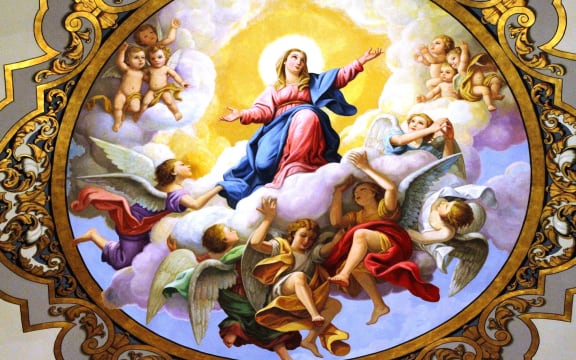
Fresco depicting the Assumption of Mary Photo: Wikimedia Commons
Performed by Anne Loeser (baroque violin), Jane Young (baroque cello), Bethany Angus (harpsichord)
The fourth Glorious Mystery is The Assumption of Mary into Heaven. Here we step into new territory. All of the previous thirteen Mysteries of the Rosary are meditations on events which took place on earth and are recorded in the Gospels written within a hundred years or so of those events. From The Assumption onwards we are dealing with events which are believed to have taken place in heaven and there is no record of them in the Bible. There is no contemporaneous account of how, or even if, Mary died before her Assumption into Heaven.
Biber's Assumption of Mary into Heaven is in D major. Its scordatura is relatively benign: the two lower strings are raised a tone, and the highest string dropped a tone, giving us A-E-A-D.
The Assumption of Mary into Heaven begins with an improvisational introduction with no tempo marking. This is followed by an Aria with variations. To start with, the Aria is rather Sarabande-like but as the variations increase in intricacy, the Sarabande aspect is lost and the whole thing eventually falls over into a really joyously celebratory Gigue. As The Assumption is completed and Mary disappears from sight, so too does the violin.
Programme note by Gregory Hill.
Producer/engineer: David McCaw
BIBER: Mystery Sonata No 15, The Coronation of Mary
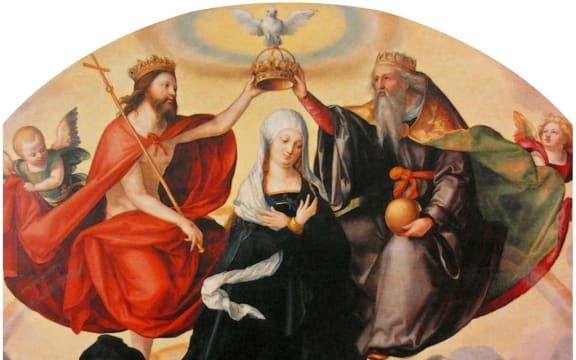
Image depicting Mary's Coronation Photo: Wikimedia Commons
Performed by Anne Loeser (baroque violin), Jane Young (baroque cello), Bethany Angus (organ)
The final Mystery of the Rosary is The Coronation of Mary in Heaven. This is another Mystery without a contemporaneously recorded backstory. Mary has only been worshipped as The Queen of Heaven (Regina Coeli) since perhaps as late as the twelfth century. Of course, to be a legitimate queen she must have been actually crowned, and including her Coronation in the Mysteries ensures that the belief will endure.
Biber's Coronation of Mary in Heaven is in C major, with a resonant, open sounding scordatura of two G’s, a C and a D. There are four distinct movements. The first, titled Sonata, is followed by an Aria with three variations. Interestingly enough the Aria is based on the same melody that Handel used sixty years later for the Amen at the end of Messiah. The Rosary Sonatas were not published until the very end of the 19th century; they disappeared, unknown, following Biber's death in 1704, and were unheard-of until their discovery in Munich a hundred and eighty years later. Therefore, Handel cannot have picked up his Amen melody from Biber. Did they both use a well-known hymn tune? Or was it a complete coincidence?
Biber follows his Aria and variations with a Canzon which again makes use of the same familiar Amen melody. The final Mystery of the Rosary finishes with a Sarabanda, that melancholic slow Spanish dance of Mexican origin. The second half sounds like a romantic rubato is being employed but no, it's actually written out like that. There are no trumpets and drums at Mary’s Coronation, The Glorious Mysteries conclude with beauty, grace, and a minimum of fuss.
Programme notes by Gregory Hill.
Producer/engineer: David McCaw
BIBER: Passacaglia, The Guardian Angel
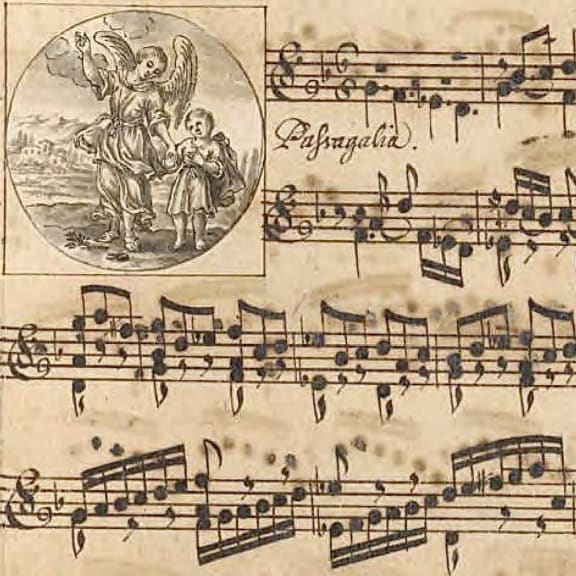
Passacaglia manuscript with the Guardian Angel engraving Photo: Wikimedia Commons
Performed by Anne Loeser (baroque violin)
The set of 15 Mystery Sonatas as they were discovered in Munich a hundred and thirty years ago concludes with a 16th sonata, not part of The Mysteries of the Rosary but an obvious adjunct to them. This is the Passacaglia in G minor, known as The Guardian Angel. Why The Guardian Angel? In the autograph scores, a space was left in the top left-hand corner of each sonata, and a small copper plate engraving affixed. Each engraving is of a scene from The Mysteries of the Rosary, and identifies its sonata with that mystery. Number 16, the Passacaglia, has an illustration of a Guardian Angel holding a child’s hand, which is not a part of the Rosary.
Rather adventurously Biber scored his Passacaglia for violin alone. Forty years before J.S. Bach’s sonatas and partitas, the idea of solo violin without basso continuo was almost unheard of. And after fourteen different travails with scordatura throughout the entire cycle, we have finally returned to the correctly tuned violin in fifths, which was last heard two hours of music ago in the very first Joyful Mystery of the Rosary, The Annunciation.
A passacaglia is a dance where a short phrase is repeated in varied ways over and over. Biber’s Passacaglia’s opening four-note descending phrase is ‘The Guardian Angel’ and it never leaves us. Biber adds all sorts of things to it, but it is always, literally, there. Sixty-five times. Even when the music is black with hemi-demi-semiquavers, The Guardian Angel will guide us through. You can depend on it.
Programme note by Gregory Hill.
Producer/engineer: David McCaw
Reflections on Biber’s Mystery Sonatas by Gregory Hill.
The Catholic church establishment in Salzburg had a disproportionate influence on Austrian music in the 17th and 18th centuries. The young Mozart was in the employ of the Archbishop for a while, so was his father Leopold, and Joseph Haydn’s younger brother Michael. The prominence of Salzburg’s musical legacy was established in the late 17th century by Heinrich Ignaz Franz von Biber. Biber was recognised by many at the time as perhaps the finest violinist alive. Biber’s “Rosary” or “Mystery” Sonatas represent the pinnacle of his violin writing.
The Rosary is a part of Roman Catholic worship, basically unchanged since the middle ages. It is essentially the practice of meditations on the fifteen Mysteries, fifteen events in the life of the Virgin Mary and her son Jesus Christ. For each Mystery the devotee verbalises the Lord’s Prayer, ten Hail Marys and the Glory Be, whilst meditating on that mystery. You can keep track of how many Hail Marys you have recited on your Rosary beads. From the 15th Century onwards, images, drawings and paintings came to be used as aids to this meditation. In the 17th Century, Heinrich Biber took meditational assistance a step further with his cycle of the Mystery Sonatas, one specifically for each Mystery.
We do not know a lot about Biber’s Mystery Sonatas. We do not even know when they were written, although we can guess at somewhere around 1680. We do, however, know that they were written for Biber’s employer, the Archbishop of Salzburg, Maximilian Gandolph von Khuenberg. Maximilian Gandolph had been educated by Jesuits and was an ardent Rosary worshipper. Heinrich Biber was also Jesuit-educated. In fact his two middle names, Ignaz Franz, Ignatius Francis, which he adopted himself (they’re not on his birth certificate), are the names of two of the Jesuit Order’s founders.
There is no record of any contemporary performance of the Mystery Sonatas. Where and why were they performed? For such sacred subject matter, they are remarkably unholy. Surely all those dance movements were not intended for use in church? The Sonata da Chiesa (Church Sonata) was an established form used by Biber elsewhere, but there is not one among the Mystery Sonatas. In fact most of them are not sonatas at all, the extensive use of dance movements defines them more accurately as Partitas or Suites. Perhaps they were for intimate meditation in the Archbishop’s quarters. Or something on a larger scale in the Aula Academica, the great hall used for the devotions of the Confraternity of the Assumption of the Virgin, still standing in Salzburg today and hung with paintings of the Mysteries of the Rosary.
There are 16 Sonatas in all: 5 Joyful Mysteries reflecting on the birth and life of Jesus up to the age of twelve, 5 Sorrowful Mysteries relating to torments suffered by Jesus in the last twelve or so hours of his life on earth, 5 Glorious Mysteries referring to events from the Resurrection to the establishment of Mary as the Queen in Heaven, and a concluding Passacaglia.
The manuscript of Biber’s Mystery Sonatas was discovered in the Bavarian State Library in about 1890. They had never been published or disseminated. In the previous 180 years, nobody had heard them, or heard of them. The title page is missing, so we do not know what Biber called them, but we know from Biber’s enthusiastic accompanying dedication letter to the Archbishop of Salzburg, that they were written to the honour of the 15 Sacred Mysteries. The individual mysteries are not named either but at the top of each sonata a space has been neatly left blank and a little round copperplate engraving affixed. Each of the 15 engravings represents a mystery of the Rosary, and identifies its sonata with that mystery. The engravings are for the performer, to help them fulfil their part of the meditation.
Scordatura

Anne Loeser's baroque violin with strings crossed over Photo: Anne Loeser
One of the extraordinary aspects of the Mystery Sonatas is Biber’s use of Scordatura. The word Scordatura comes from the Italian verb Scordare; to mistune. Not retune, or differently tune, but mistune. The standard tuning of the violin’s four strings is in fifths: G-D-A-E. Scordatura is where some or all of the strings on an instrument are deliberately mistuned to different notes to create new technical and aural possibilities. All sorts of new multiple stops present themselves, and new brighter, duller, louder, quieter sonorities are available depending on the relationship of the music’s tonality to the particular scordatura being employed. Scordatura floats to the surface occasionally throughout music’s history, but Biber was apparently obsessed with it. In the Mystery Sonatas he extended the possibilities of scordatura, and the violin itself, almost to breaking-point.
Here are some interesting guidelines Biber follows in his choice of scordatura for the Rosary Sonatas. He never lowers the bottom string; he only raises it. He never raises the top string; he only lowers it. Apart from one sonata in The Sorrowful Mysteries, Biber always has two strings on the same note an octave apart.
With the exception of the first Sonata (not in this programme) and the Passacaglia, each of the remaining fourteen Mysteries is in a different scordatura or mistuning. This creates a huge stress on the violin, and the violinist. The written notes are not the notes you hear, they are the notes you should finger as if the violin was properly tuned, and so what comes out of the mistuned strings is different to what you see and what you thought you played. An intended unison on 2 strings can look like a jarring discord a tone apart but sounds as a unison. So rather than the written music showing the shape and the actual notes to be played, it is more of a fingering chart - a tablature.
The practice of the Rosary is a ritual. One creates for oneself a physical and mental space to repetitively reflect and contemplate on faith. Biber’s Rosary music is all of that for the performer as well. First you create the unique scordatura for the particular mystery. Then the mind enters the space to decode the meaningless black dots in the terms of the scordatura. The performer takes a leap of faith and the scordatura turns all those misprinted notes into the right ones, and the spell is created. It is a rather other-worldly experience for both the violinist and the devotee.
The temperamental gut strings of the baroque violin react badly to having their tuning changed five times in one performance, as every new tension is unstable until it has had time to settle in. So as a partial solution to this problem, Anne Loeser plays four different baroque violins, each tuned in a different scordatura.
Concert recorded 17 April 2022, St Mary of the Angels, Wellington by RNZ Concert
Producer/engineer: David McCaw

